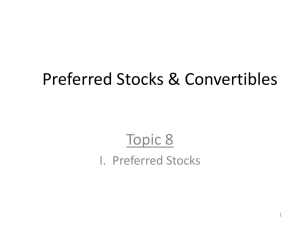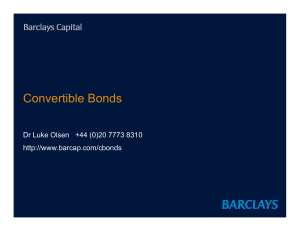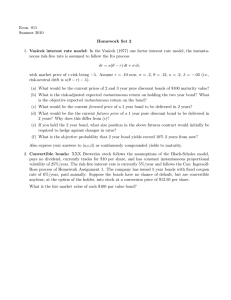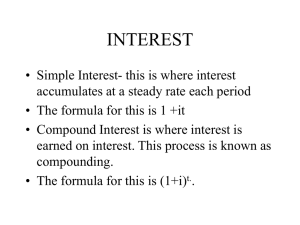Document 14246906
advertisement
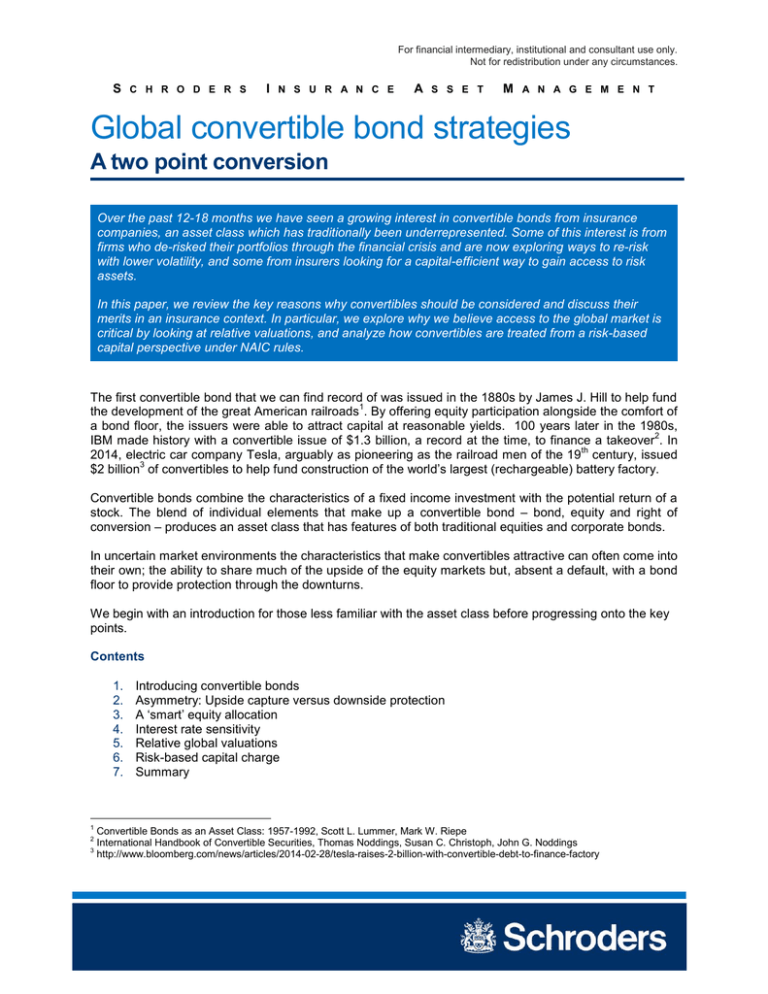
For financial intermediary, institutional and consultant use only. Not for redistribution under any circumstances. S C H R O D E R S I N S U R A N C E A S S E T M A N A G E M E N T Global convertible bond strategies A two point conversion Over the past 12-18 months we have seen a growing interest in convertible bonds from insurance companies, an asset class which has traditionally been underrepresented. Some of this interest is from firms who de-risked their portfolios through the financial crisis and are now exploring ways to re-risk with lower volatility, and some from insurers looking for a capital-efficient way to gain access to risk assets. In this paper, we review the key reasons why convertibles should be considered and discuss their merits in an insurance context. In particular, we explore why we believe access to the global market is critical by looking at relative valuations, and analyze how convertibles are treated from a risk-based capital perspective under NAIC rules. The first convertible bond that we can find record of was issued in the 1880s by James J. Hill to help fund 1 the development of the great American railroads . By offering equity participation alongside the comfort of a bond floor, the issuers were able to attract capital at reasonable yields. 100 years later in the 1980s, 2 IBM made history with a convertible issue of $1.3 billion, a record at the time, to finance a takeover . In th 2014, electric car company Tesla, arguably as pioneering as the railroad men of the 19 century, issued 3 $2 billion of convertibles to help fund construction of the world’s largest (rechargeable) battery factory. Convertible bonds combine the characteristics of a fixed income investment with the potential return of a stock. The blend of individual elements that make up a convertible bond – bond, equity and right of conversion – produces an asset class that has features of both traditional equities and corporate bonds. In uncertain market environments the characteristics that make convertibles attractive can often come into their own; the ability to share much of the upside of the equity markets but, absent a default, with a bond floor to provide protection through the downturns. We begin with an introduction for those less familiar with the asset class before progressing onto the key points. Contents 1. 2. 3. 4. 5. 6. 7. 1 Introducing convertible bonds Asymmetry: Upside capture versus downside protection A ‘smart’ equity allocation Interest rate sensitivity Relative global valuations Risk-based capital charge Summary Convertible Bonds as an Asset Class: 1957-1992, Scott L. Lummer, Mark W. Riepe International Handbook of Convertible Securities, Thomas Noddings, Susan C. Christoph, John G. Noddings 3 http://www.bloomberg.com/news/articles/2014-02-28/tesla-raises-2-billion-with-convertible-debt-to-finance-factory 2 1. Introducing convertible bonds A convertible bond is a corporate bond with the added feature of a conversion right (option). The buyer has an option to convert the bond into shares of the company at a pre-determined quantity and price as defined in the prospectus. Figure 1, below, shows the three main stages of a convertible bond’s profile. 1. In the left-hand ‘bond-like’ stage, the bond will be valued similarly to any other corporate bond – the present value of its future cash-flows (principal and coupons) minus a spread to reward investors for credit and other risks – plus a premium for the value of the embedded option. 2. In the middle ‘hybrid’ stage, the embedded option becomes key because if it were converted the shares could be acquired at or less than their market price. This is the sweet spot where the two competing characteristics; equity and bond-likeness play off against each other. It is where an active manager’s security selection has the potential to add significant value to a portfolio. The value of the equity to bond components is the bond’s convexity, which we explore in Section 3. 3. In the ‘equity-like’ stage, the value of the conversion option dominates the bond and its value through this stage will be driven by the price of the underlying equity. Source: Schroders; for illustration purposes only. All investments involve risk, including the risk of loss of principal. 2. Asymmetry: Upside capture versus downside protection Sudden and significant equity market shocks are becoming increasingly common. In August and September 2015, global stock markets lost more than 10% before recovering in October. On each occasion, convertibles generally held up well, experiencing about half of the equity market losses. The chart below shows the Thomson Reuters Global Convertibles index’s drawdowns and those of the comparable equity index during the precipitous market falls of 2008, 2011 and more recently. S C H R O D E R S I N S U R A N C E A S S E T M A N A G E M E N T 160 140 120 100 80 60 40 20 0 Equity (MSCI World AC) Convertible Bonds (Thomson Reuters Global Focus USD hedged) st Figure 2: Thomson Reuters Global Focus vs MSCI World to 31 January 2016. Past performance is not a guide to future performance. The smaller drawdown has the obvious benefit of reducing volatility relative to equities, as illustrated by the realized volatility of the convertible bond index, shown against the same global equity index in the chart below. 70% 60% Volatility 50% 40% 30% 20% 10% 0% Apr/06 Apr/07 Apr/08 Apr/09 Apr/10 Apr/11 Apr/12 Convertible Bonds (Thomson Reuters Global Focus USD hedged) Apr/13 Apr/14 Apr/15 Equity (MSCI World AC) st Figure 3: Global Convertible Index vs MSCI World to 31 January 2016. Past performance is not a guide to future performance. To explore this relationship further, we have compared the index’s upside participation and maximum drawdown to the equity index in Figures 4 and 5. Figure 4 shows almost 70% capture over the past five years, whilst Figure 5 shows convertibles suffered only 17% of the equity drawdown, with small negative drawdowns in two periods despite equity market downturns in four of the five. Over this time period, investors have benefitted disproportionately to the upside, capturing most of the gains in the share prices but suffered much less of their falls. S C H R O D E R S I N S U R A N C E A S S E T M A N A G E M E N T 20% 15% 10% Upside participation 5% 0% Rolling 1Y Rolling 2Y Rolling 3Y Rolling 4Y Rolling 5Y 5% 0% Downside protection -5% -10% -15% Convertible Bonds (Thomson Reuters Global Focus USD hedged) Equity (MSCI World AC) st Figures 4 & 5 – Source: Schroders, rolling 1,2,3,4 and 5 year periods to 31 January 2016. Past performance is not a guide to future performance. 3. A ‘smart’ equity exposure through convexity In Sections 1 and 2 we introduced convexity; it is the ratio of upside versus downside capture relative to the underlying equity. Where convexity is most valuable to the investor is where participation in appreciation of the underlying equity is high, but in falls of the underlying less so. Convexity of convertible bonds can be an effective tool for automatically timing the market. Convexity intrinsically decreases the proportional equity exposure when the underlying equity falls. Importantly though, the equity exposure accelerates again in rising markets. Active exposure management and good security selection both on the equity and bond side is very important to identify bonds with good underlying fundamentals that would be expected to exhibit high convexity. 4. Interest rate sensitivity In our view, convertibles have a couple of strengths over corporate bonds from an interest rate risk perspective. Firstly, rate rises usually coincide with periods of strong economic growth, so the equity feature should benefit from this. Secondly, the embedded conversion right not only allows us to receive the equity, but also includes a sell of the fixed income component, in effect a put option. These exotic puts can reduce duration significantly. In the chart below we have compared the convertible bond index with Government, corporate bond and high yield indices through the last two sustained periods of rising federal reserve rates (so excluding December 2015). In both periods, convertibles perform markedly well. S C H R O D E R S I N S U R A N C E A S S E T M A N A G E M E N T st Figure 6: Source: Bloomberg, using compounded monthly returns as at 31 January 2016. ‘ML’ is Merrill Lynch. Past performance is not a guide to future performance. Other periods would have achieved different results. 5. Relative global valuations The convertible bond market is small compared to the wider corporate bond market; in the US for 4 5 example, the convertible bond market is approximately $200 billion versus the $9.6 trillion corporate bond market. By accessing the global convertible marketplace we gain access to more than double the 5 opportunity set, or approximately $500 billion , as well as benefitting from diversification across regions and markets. As with most strategies, calling the sector/country allocation correctly can be as important as the individual security selection. Restricting a portfolio to just one market can lead to missed opportunities; as fundamental in our view for delivering alpha in convertible portfolios is the ability to spot cheap valuations, act on mispricing and buy convexity. The chart below, based on a proprietary convertible bond valuation model from Nomura, shows the pricing fluctuations between the regions. The fluctuations between regions are evident, as is the current near four year valuation lows in Asia ex-Japan, Japan and the Americas. It is therefore key to be able to search for and find attractive bonds worldwide. Expensive Cheap Figure 7: Source: Nomura, Schroders, February 2016. AEJ is Asia ex-Japan. Past performance is not a guide to future performance. 4 5 UBS Convertible Research/MACE, 2015 Source: UBS AG S C H R O D E R S I N S U R A N C E A S S E T M A N A G E M E N T 6. Risk-based capital charge There is another reason why insurance investors may consider convertible bonds – they are highly capital-efficient under the NAIC’s RBC regime and can be highly attractive on a risk-adjusted return on capital (RAROC) basis. Bonds Life P&C Health NAIC Class 1 (AAA, AA, A) 0.4% 0.3% 0.3% NAIC Class 2 (BBB) 1.3% 1% 1% NAIC Class 3 (BB) 4.6% 2% 2% 22.5% - 45% (Beta adjustment) 15% 15% Equity Common th 6 Figure 8: Source: NAIC, life factors are on a pre-tax basis, as at 15 February 2016 Again taking the convertible bond index as an example, it has captured almost 70% of the equity markets over the past five years but with an approximate RBC charge of 2.77% for Life Insurers and 1.38% for 7 P&C and Health Insurers , a fraction of the equivalent common equity capital charge. We expect demand for convertibles to rise from Europe-based insurance companies subject to Solvency II, since the Solvency Capital Requirement of convertibles is also considerably lower than for listed equities (39%-49% under the standard model). 7. Summary Convertible bonds have a number of features that may make them an attractive asset class and, as this analysis has aimed to demonstrate, features that should be of particular interest in the current volatile market conditions. Furthermore, the relative lower duration of convertible portfolios and the equity upside afforded by the conversion option are valuable qualities in an interest rate environment that will likely rise, however gradually, in the coming years. A focus on credit quality is particularly important for insurance companies keen to avoid impairments, and so investment managers need both strong equity and credit analysis capabilities. Portfolios can be designed to deliver closer to equity or fixed income characteristics based on each client’s existing asset profile and risk budget. At Schroders we believe that convertible strategies with a focus on bonds with high convexity and strong momentum, after a careful analysis of the fundamental credit quality of the issuer, can be very well suited to insurers’ general account investment portfolios and are well worthy of consideration. To discuss these ideas with us further, please contact the insurance group. +1-212-488-1515 insurance.us@schroders.com www.schroders.com/usinsurance 6 7 http://www.naic.org/documents/committees_e_capad_investment_rbc_wg_rbc_factor_status_matrix.pdf?1234 Source: Schroders, based on holdings as at 31st January 2016. For illustration only. S C H R O D E R S I N S U R A N C E A S S E T M A N A G E M E N T About Schroders Insurance Asset Management Schroders is a full-service asset manager with $446.5 billion in assets under management, we have been managing assets for insurance clients since 1972 and now have $71.3 billion of external insurance client assets under management*. The insurance group offers investment strategies, risk and capital management expertise, dedicated actuarial services, reporting and servicing, all tailored to meet insurers’ unique needs. To find out more please visit www.schroders.com/usinsurance th *as at 30 September 2015. Risks: All investments involve risk, including the risk of loss of principal. Convertible bonds are subject generally to call, interest rate, credit, market, and liquidity risks, to varying degree. Non-investment grade securities will generally pay higher yields than more highly rated securities but will be subject to greater market, credit and default risk. A security issuer may not be able to meet its obligations to make timely payments of interest and principal. This will affect the credit rating of those securities. Investments denominated in a currency other than that of the share-class may not be hedged. The market movements between those currencies will impact the share-class. Investment in bonds and other debt instruments including related derivatives is subject to interest rate risk. The value of the fund may go down if interest rate rise and vice versa. It may be difficult to sell quickly positions of one or more companies to meet redemption requests upon demand in extreme market conditions. Important Information: The views and opinions contained herein are those of Schroders US Insurance Asset Management and Schroders Convertible Bond teams, and may not necessarily represent views expressed or reflected in other Schroders communications, strategies or funds. This newsletter is intended to be for information purposes only and it is not intended as promotional material in any respect. The material is not intended as an offer or solicitation for the purchase or sale of any financial instrument mentioned in this commentary. The material is not intended to provide, and should not be relied on for accounting, legal or tax advice, or investment recommendations. Information herein has been obtained from sources we believe to be reliable but Schroder Investment Management North America Inc. (SIMNA Inc.) does not warrant its completeness or accuracy. No responsibility can be accepted for errors of facts obtained from third parties. Reliance should not be placed on the views and information in the document when taking individual investment and / or strategic decisions. The information and opinions contained in this document have been obtained from sources we consider to be reliable. No responsibility can be accepted for errors of fact obtained from third parties. The opinions stated in this document include some forecasted views. We believe that we are basing our expectations and beliefs on reasonable assumptions within the bounds of what we currently know. However, there is no guarantee that any forecasts or opinions will be realized. Past performance is no guarantee of future results. All investments involve risk, including the risk of loss of principal. SIMNA Inc. is an investment advisor registered with the U.S. SEC. It provides asset management products and services to clients in the U.S. and Canada including Schroder Capital Funds (Delaware), Schroder Series Trust and Schroder Global Series Trust, investment companies registered with the SEC (the “Schroder Funds”.) Shares of the Schroder Funds are distributed by Schroder Fund Advisors LLC, a member of the FINRA. SIMNA Inc. and Schroder Fund Advisors LLC are indirect, wholly-owned subsidiaries of Schroders plc, a UK public company with shares listed on the London Stock Exchange. Schroder Investment Management North America Inc. is an indirect wholly owned subsidiary of Schroders plc and is a SEC registered investment adviser and registered in Canada in the capacity of Portfolio Manager with the Securities Commission in Alberta, British Columbia, Manitoba, Nova Scotia, Ontario, Quebec, and Saskatchewan providing asset management products and services to clients in Canada. This document does not purport to provide investment advice and the information contained in this newsletter is for informational purposes and not to engage in a trading activities. It does not purport to describe the business or affairs of any issuer and is not being provided for delivery to or review by any prospective purchaser so as to assist the prospective purchaser to make an investment decision in respect of securities being sold in a distribution. Further information about Schroders can be found at www.schroders.com/us. Further information on FINRA can be found at www.finra.org. Further information on SIPC can be found at www.sipc.org. Schroder Fund Advisors LLC, Member FINRA, SIPC. 875 Third Avenue, New York, NY 10022-6225.
